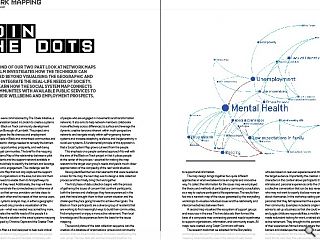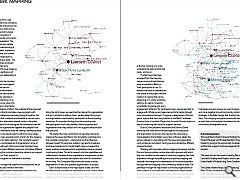Network Mapping: Join The Dots
23 Jan 2023
In the second of our two part look at network maps Urban Realm investigates how the technique can be extended beyond visualising the geographic and virtual to integrate the real-life needs of society. Here we learn how the social system map connects target communities with available public services to improve their wellbeing and employment prospects.
In summer 2021 we were commissioned by The Ubele Initiative, a Black diaspora organisation based in London to create a systems map as part of their Black on Track community development project in the London Borough of Lambeth. The project aims to support and progress the life chances and employment opportunities of people in Black and minoritised communities and address deeper systemic change needed to remedy the barriers that are limiting the opportunities, prosperity, and well-being of citizens in the target communities. The brief for the mapping was to create a Systems Map of the relationship between a pilot group of Black residents and the support network available in the Borough that would help to identify the barriers and leverage points to their economic engagement. The challenge was for us to design a Systems Map that not only captured the support services, groups and organisations in the area, but also link them to the user groups needs to enable them to find pathways to the help and support they need. Additionally, the map will have the potential to demonstrate the connectedness or otherwise of support ecosystem so that service providers can take steps to improve links with each other and the needs of their service users.
A conventional systems analysis map, in either a geographic or network format would only provide a visualisation of the services infrastructure – what was needed was something more, that would incorporates the real life needs of the people it is aiming to help. We found a solution in the social systems mapping frameworks developed by Christine Capra and the Greater Than the Sum collective: A Social System Map is a tool designed to help build critical mass and momentum behind tipping points and to help people within social eco-systems to see and navigate complexity with the aim of amplifying and accelerating the system-change efforts of people who are engaged in movements and transformation networks. It also aims to help network members collaborate more effectively across differences; to surface and leverage the dynamic creative tensions inherent within multi-perspective networks and navigate wisely within self-organizing human systems and increase adaptivity, resilience and (re)generativity in social eco-systems. A fundamental principle of this approach is that a Social System Map grows outward from the people.
This emphasis on a people centered approach fits well with the aims of the Black on Track project in that it places people at the center of the process - essential for making the map relevant to the target user group’s needs and yield a much closer approximation of the complexity of the real-world situation. Having identified the two main elements that were needed as a basis for the map, the next step was to design a data collection process and then finally bring the two together. The first phase of data collection begins with the process of gathering the issues of concern that confront participants; both the barriers and challenges they have experienced in the past that have brought them to their current situation and the challenges they face going forward to achieve their goals. The Black on Track participants are a diverse group of residents that are working to find meaningful ways to build their communities, find employment or enjoy a more active retirement. Their local knowledge and life experiences form the basis for the issues mapping. The second phase of the data collection sequence was the creation of a database of organisations, groups and community enablers that are linked to the issues of concern identified by the user group.
The two data sets are then brought together in a composite network map that enables users to explore pathways to support and information. The map design brings together two quite different approaches in what we believe to be an original and innovative way. To collect the information for the issues map we employed the theory and methods of participatory community consultation, as a way to capture participants life experiences. The results then fed into a network map of the issues generated by the storytelling workshops to visualise individual issues and the relationality and interconnectedness between them. A second map visualised the ecosystem of support groups and resources in the area.
The two data sets then formed the basis of a composite map connecting personal needs to pathways to support organisations, information, and community assets. All maps were created using Graph Commons software The research tools that we adopted for the Storytelling workshop are derived from persona creation and user journey mapping, tools frequently used in the design of web-based products and services. Personas are fictional characters, or actors who are based on real user experience and information about the target audience. Importantly the creation of fictionalised characters in this context allows participants to transfer their often intimate and personal experiences onto the character, facilitating a collective conversation that can be less revealing for individuals who may not want to openly disclose more sensitive information about themselves.
In the workshop setting participants created personas that they felt represented the experience of people in their community. Examples included a single mother needing advice to set up a business so that she could work from home and juggle childcare responsibilities, a middle-aged man recently made redundant looking for work, a retired elder seeking an active retirement. They brought to the personas a rich narrative of their experiences framed around where they started from, the barriers and challenges they experienced in education and work and their aspirations for the future. These scenarios formed the basis for the next step, the user journey mapping. They then took the persona characters on a journey of transformation. In its most basic form, user journey mapping starts by compiling a series of user goals and actions into a timeline framework which is then built into a narrative that includes user thoughts and emotions. It combines two powerful instruments: storytelling and visualisation.
The persona journeys act as a vehicle to gain a greater understanding of the user group’s needs, aspirations, barriers, expectations, and current circumstances and help them to identify, set and achieve goals. The storytelling workshops produced a list of approximately sixty participant issues, the issue mapping demonstrates the significance of some issues and their relationality to others. Our research into the provision of information about local support services showed that service providers published information through the different service areas of the local authority websites in the form of static directories or as printed leaflets. In some cases, this has led to both gaps in information provision and duplication of effort.
The potential of the proposed systems mapping is that it promotes a new approach with information from multiple sources being brought together into a central database that is relevant and available to service users. As a great deal of this information already exists in the public domain, what appears to be missing are the connectors that link sectors, groups, and organisations together and people in the community to the information they are seeking. Identifying these missing connectors provided a basis for defining more closely the purpose of the map, essential points of entry for the mapping process and a focus for data collection. The ‘Lambeth support system’ is a loosely coordinated set of organisations; some of which collaborate with each other and whose members have different goals, command different resources, and follow different processes.
Mapping this complex interactive network can support efforts in the Black on Track project to: Identify possible support for individual or business development. Chart pathways through the systems and evaluate the ‘touch points’ where the users interact with them. Pinpoint areas where greater collaboration between map members could benefit the target group. Identify leverage points where interventions might improve the way the systems work for the target group. Using the list of issues, we searched the internet for organisations acting in Lambeth to address them, we also added the groups and organisations mentioned by participants in the storytelling workshop. An important finding from the workshop was that participants could only identify a few local groups and organisations that they would turn to for support and advice for their persona. We started the map construction as described above by mapping the issues identified in the storytelling workshop and their possible connections – asking what are the influences between issues? For example, isolation may lead to loneliness and have implications for mental health.
Having mapped the issues, we then considered which organisations have an interest in addressing these. This led to research into the capabilities and collaborations between these organisations as expressed on their websites, which provided descriptions and a set of connections for the map. The Composite Map shows the issues (in blue), organisations (in red) and possible opportunities (in purple). Each clickable node on the maps opens a data card with information that describes the organisation and its contact details. On the right of the card is a list of the organisations that it works with (red) and the issues it addresses (blue). That list is organised by the number of connections these nodes have with the most at the top. Clicking on a node will lead to the data card for that node... and so on. The Net maps that have emerged from the mapping sequence are not tools that are easily accessible to Black on Track participants to use. To address the issue of useability the final phase of the project was the creation of a game that can be played live or in online workshop settings.
As well as increasing accessibility the game acts as an engagement ‘attractor” for participants who may be reluctant to engage with official support agencies and information through more conventional channels. The game is designed as a Domino game, a game that has a long tradition in the Black Caribbean Domino clubs in Lambeth. Players link the cards Domino style as a way of connecting their issues to support services. Due to Covid pandemic restrictions the Domino Game workshop was held online with participants choosing issue and organisation cards from the map and the cards being manipulated by the facilitator using Quip software. Ideally the game is played in a live setting with the issue and organisation cards printed as card decks. Card types are indicated by different coloured borders. Working with the social systems mapping framework and the Domino Game provides communities with a process with which they can visualise the real needs of citizens by mapping their lived experience through storytelling and user journey mapping and secondly the strengths and weaknesses of the social ecosystem through network mapping of the community resource base.
The pathways through the map enable community organisations to work together to build networks and alliances to better identify the true needs of the target user groups. This is an approach that gives the voices of Black and minority communities a central role in the process of identifying issues and resolving them. Individuals and user groups can use it to begin conversations and come together to build community, individual resilience and strategies to facilitate change that is led by them and not done to them. The mapping and game process also have great potential as tools that can be adapted to address the other complex community development issues.




